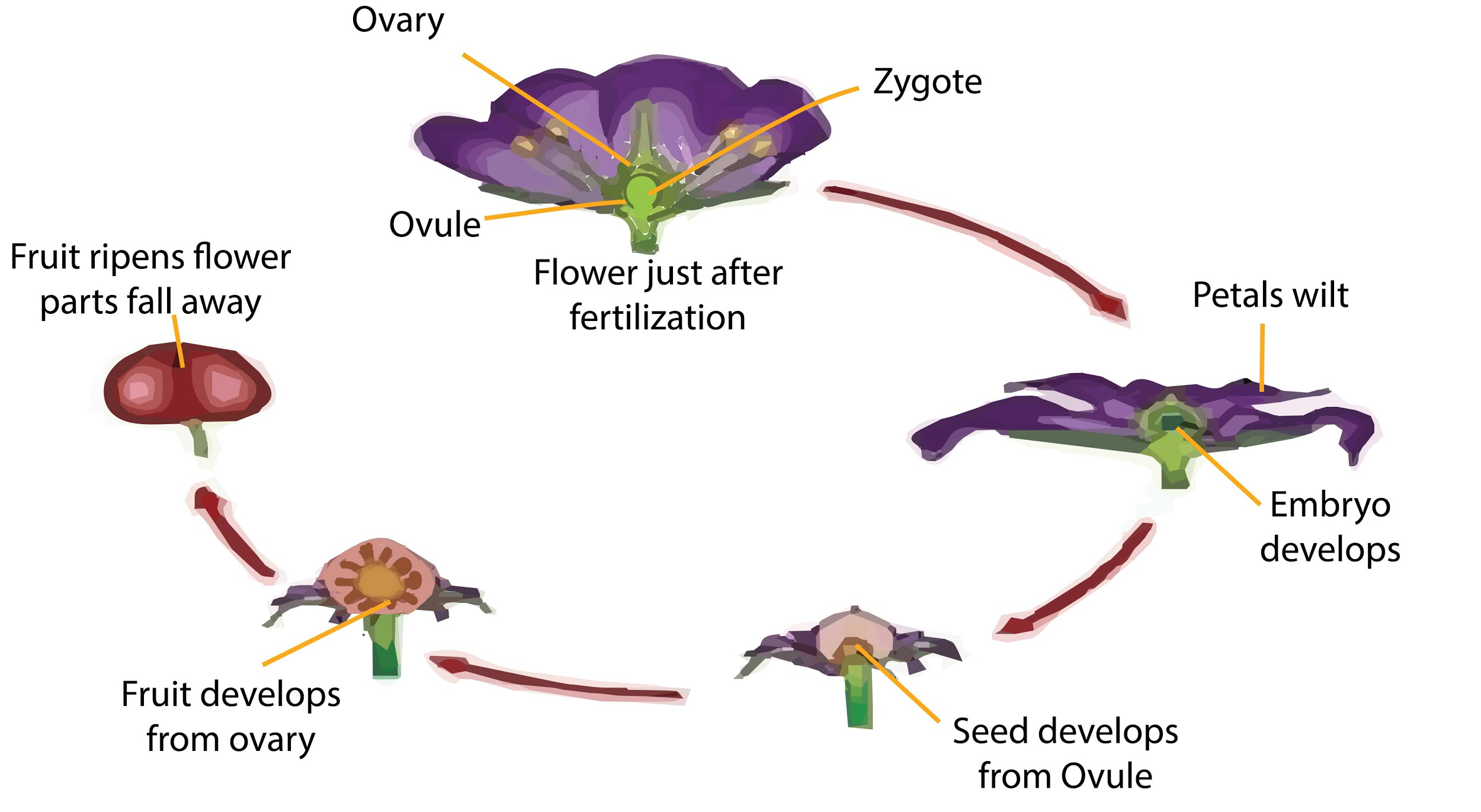
Describe the post-fertilization changes in a flower.
Answer
482.7k+ views
Hint: Fertilization is the process of fusion of the male and female gametes to form a zygote that results in the process of fertilization and leads to the formation of the seeds from which a new plant is developed.
Complete answer:
The flowering plants (angiosperms) consist of a 7-celled gametophyte which has two polar nuclei, one egg cell, two synergids, and three antipodal cells. The two male gametes are produced, one of the male gametes fuses with an egg cell and forms a zygote while the other one gamete fuses with the polar nuclei which result in the formation of the endosperm.
After this process of double fertilization, several changes may occur which includes:
-The development of the embryo and the endosperm.
-The development of the ovules into the seeds.
-The ovary will develop and mature to form a fruit.
-The zygote will undergo certain division and give rise to two cells, one is the basal cell and the other is the terminal cell.
-The basal cell will undergo divisions to form a suspensor, which helps in providing nutrition and attachments to the plants.
-The terminal cell will undergo various divisions to form an embryo which will again divide to form a different embryonal stage and further divides and mature to form a seed.
-The outer sepals and petals along with the stamens of the flowers will fall off while the pistil remains attached to the flower.
-The wall of the ovary will form a protective covering outside the fruit which is known as the pericarp.

Note: In 1884, Strasburger showed that the pollen tube releases two male nuclei along with the vegetative nucleus inside the embryo sac. Later Nawaschin discovered that the event of fertilization involved two events in the case of the flowering plants. In animals, the process of fertilization first showed by Wilhelm August Oscar Hertwig.
Complete answer:
The flowering plants (angiosperms) consist of a 7-celled gametophyte which has two polar nuclei, one egg cell, two synergids, and three antipodal cells. The two male gametes are produced, one of the male gametes fuses with an egg cell and forms a zygote while the other one gamete fuses with the polar nuclei which result in the formation of the endosperm.
After this process of double fertilization, several changes may occur which includes:
-The development of the embryo and the endosperm.
-The development of the ovules into the seeds.
-The ovary will develop and mature to form a fruit.
-The zygote will undergo certain division and give rise to two cells, one is the basal cell and the other is the terminal cell.
-The basal cell will undergo divisions to form a suspensor, which helps in providing nutrition and attachments to the plants.
-The terminal cell will undergo various divisions to form an embryo which will again divide to form a different embryonal stage and further divides and mature to form a seed.
-The outer sepals and petals along with the stamens of the flowers will fall off while the pistil remains attached to the flower.
-The wall of the ovary will form a protective covering outside the fruit which is known as the pericarp.

Note: In 1884, Strasburger showed that the pollen tube releases two male nuclei along with the vegetative nucleus inside the embryo sac. Later Nawaschin discovered that the event of fertilization involved two events in the case of the flowering plants. In animals, the process of fertilization first showed by Wilhelm August Oscar Hertwig.
Recently Updated Pages
Master Class 11 Accountancy: Engaging Questions & Answers for Success

Glucose when reduced with HI and red Phosphorus gives class 11 chemistry CBSE

The highest possible oxidation states of Uranium and class 11 chemistry CBSE

Find the value of x if the mode of the following data class 11 maths CBSE

Which of the following can be used in the Friedel Crafts class 11 chemistry CBSE

A sphere of mass 40 kg is attracted by a second sphere class 11 physics CBSE

Trending doubts
10 examples of friction in our daily life

Difference Between Prokaryotic Cells and Eukaryotic Cells

State and prove Bernoullis theorem class 11 physics CBSE

What organs are located on the left side of your body class 11 biology CBSE

Define least count of vernier callipers How do you class 11 physics CBSE

The combining capacity of an element is known as i class 11 chemistry CBSE




